Sigma 150mm f/2.8 EX DG APO HSM Macro Lens Review
When it comes to a dedicated macro lens, one can do much worse than the Sigma 150mm f/2.8 EX APO DG HSM Macro. The lens is a bit of an oddity when it comes to macro lenses in terms of focal length, falling between the typical 100-105mm and 180-200mm spots typical of longer macros, however, the positioning does allow the lens to be faster than the 180-200mm macros while still retaining most of the working distance and background blur.
Build
The Sigma 150mm f/2.8 macro’s build quality is somewhat middling. That’s not to say it’s generally bad; in fact, the complaints I have with the lens’s build and finish are rather minor over all.
Overall, the lens alone (without the hood or lens collar) weighs 27.2 oz. (771g), which is actually heavier than Canons 135mm f/2L or 200mm f/2.8L. With the hood, and tripod collar, the lens weighs 34.3 oz. (973g) which is almost as heavy as Canon’s 180mm f/3.5L macro lens.
The lens mounts a 72mm front filter, and has a metal lens mount.
Finish
The finish on this lens is a relatively soft, compared to other manufacturers, matte dark gray coating, not anything like the powder coated/anodized finishes on high end Canon and Nikon lenses.
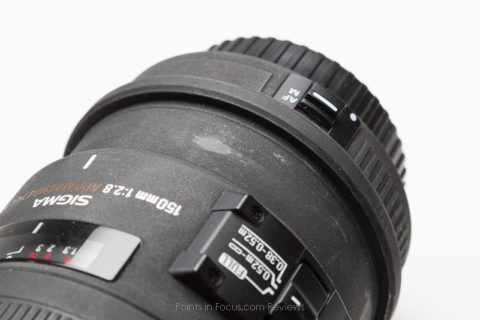
About the only positive I can say about the finish is that it’s not at all slippery to grasp/hold. Otherwise, the finish shows marks, dusk, gunk, and wear much easier than any other lens I’ve ever used, as the images in this review well testify. My 150mm f/2.8 macro is not a heavily used lens in my arsenal, in fact, it spends a great majority of its time in either its case or in a padded drawer, and yet the surface is pretty well marred from the little use it gets. Fortunately, Sigma has addressed the mediocre finish on their EX lenses with more recent lenses like the 150mm f/2.8 EX DG OS HSM APO Macro that replaces the lens being reviewed here.
Tripod Collar
The Sigma 150mm macro comes with a tripod collar, which is a nice touch given the weight of the lens. The collar uses the “split in half and lock” style, where there’s a hinge on one side and a locking mechanism on the other. The locking mechanism can be tightened and loosened by turning the nob on the grip. To remove the collar the knob is turned to the loose position (white dot on collar and white dot on ring are aligned) and the knob pulled out away from the collar.
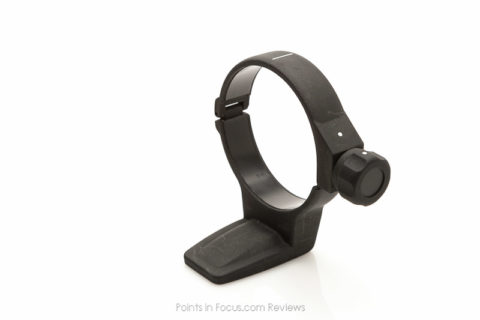
Unfortunately, the finish of the lens gets in the way of good collar operation. The inside of the collar is lined with a smooth plastic to facilitate easy rotation, but the resulting action isn’t really smooth. Compared to other tripod collars I use regularly, even the Canon add-on collar for the 70-200mm f/4L lenses, is smoother operating than the collar on the Sigma. Additionally there seems to be some issues with the evenness of the coating used, as there are distinct wear spots on my lens under the tripod collar where the finish has been smoothed down due to of rotating the lens in the collar.
Lens Hood
The final part of the puzzle is the lens hood; which comes with the lens when you buy it; a nice touch Canon should really take up with their non-L products. The hood is hard plastic and uses a bayonet mount to attach to the lens barrel. Unlike Canon hoods, the Sigma hood isn’t lined with black fabric, but rather is ridged with a saw-tooth like pattern. I can’t say I’ve ever seen much of a difference between the Canon and Sigma styles, and the hood seems to work well.
The outside of the hood is finished with the same coating as the lens, though amazingly the hood on my lens seems to have held up better than the lens barrel itself. The hood mounts and locks in place very solidly, probably due to all the friction from the coating.
Handling
The lens is laid out like any other telephoto prime, with a wide focus ring somewhat forward on the lens followed by the on-lens controls and the tripod collar. The focus ring is surprisingly wide, it’s actually wider than the grip texture suggests. Overall, the parts of the lens that turn to control focus are just shy of 2” wide (50mm) starting just behind the hood mount and continuing all the way back to just in front of the distance scale window. 1-1/8 in. (29mm) of that area is textured with a fine toothed rubber grip similar in texture to the focus rings on most Canon L lenses.
There is no play between the MF ring and the lens, so small adjustments to the focus position can be made easily.
Behind the focus ring is a 3-position focus limiter. The positions are full range, infinity to 0.38m; infinity to 0.52m (approximate 1:2 magnification); and 0.38m to 0.52m (1:1 to 1:2 magnifications). The focus throw is approximate equal in distance between infinity and 0.52m and 0.52m and 0.38m, so the limiter is both necessary and quite useful.
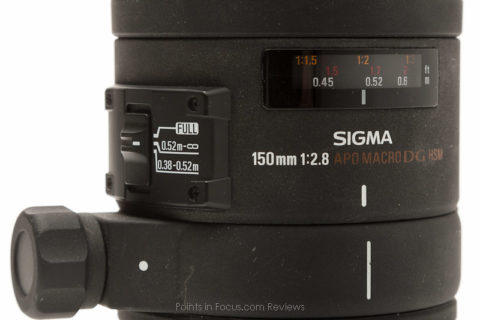
The AF/MF switch is located behind the lens ring right next to the lens mount. While I’m sure Sigma had their reasons for this, I would have preferred if they had put all the controls in the same location instead of spreading them out over the lens as they did.
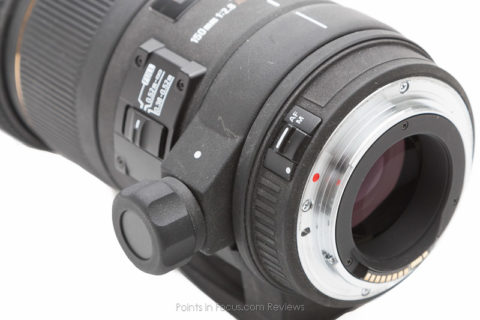
Though somewhat hefty, I’ve never had a problem with balance with this lens, even on a light body like the Rebel XTi (400D). That said, the lens is heavy enough to make using the tripod ring worthwhile. However, in a pinch, it’s certainly possible to get sharp images with the lens hanging off the camera instead of the other way around.
The lens is compatible with Sigma’s 1.4x and 2x extenders. However, the rear element isn’t inset far enough to be compatible with Canon’s.
Optics
The Sigma 150mm f/2.8 EX APO DG HSM Macro has 16 elements in 12 groups, and achieves a maximum magnification of 1:1 at 15 in. (38cm). The lens uses an internal focal design, so the lens doesn’t extend when focusing. At 1:1 magnification, you have a working distance (between the front of the lens and the subject) of about 7.9” (200mm).
| Lens | Working Distance (approx.) |
| Canon EF 100mm f/2.8L Macro IS USM | 5.24 in. ( 133mm) |
| Nikon AF-S VR Micro-Nikkor 104mm f/2.8G IF-ED | 6 in. (152mm) |
| Sigma 150mm f/2.8 EX APO DG HSM Macro | 7.9 in. (200mm) |
| Canon EF 180mm f/3.5L Macro USM | 9.85 in. (250mm) |
| Nikon AF Micro-Nikkor 200mm f/4D IF-ED | 10.24 in. (260mm) |
As a macro lens, 150mm is a bit of an odd focal length, something of a compromise between a 100mm macro and a 180mm or 200mm macro. Personally, I like the positioning; I get most of the working distances a 180-200mm macro lens would give me, along with most of the inherently cleaner backgrounds that come from a narrow angle of view. On top of that, the 150mm macro gives me a decent short telephoto with a decently fast aperture for non-macro shooting.
The lens exhibits quite a bit of vignetting, more than 2 stops in the full frame corners wide open, and stopping down only helps so much. Around f/8 the full frame corners are still close to a stop darker than the center. Crop users, either Nikon or Canon, will find that the vignetting isn’t nearly that much of an issue; wide open the corners are about a stop darker than the center, but that largely goes away by f/4 and completely by f/5.6.

The lens also does a good job controlling CA, as it’s never been noticeable in any of my images.
Focus and Auto Focus
Auto focus performance is, in my experience, on par with other macro lenses. Sigma’s implementation of an ultrasonic motor (branded Hypersonic Motor or HSM on Sigma lenses) isn’t quite on par with that of Canon and Nikon, at least not when used on those systems. Likewise, since Sigma is reverse engineering another companies AF protocol, there can be expected to be some performance differences there as well.
That said, autofocus speed isn’t unusually slow for a macro lens, and is perfectly viable in general use just as long as you’re not trying to shoot Olympic sprinters from trackside with it.
On my 40D and 1D mark 3, I found that the lens back focused by more than 2.5 depth-of-fields. On my 1D mark 3, that required a full +20 AF micro adjust and the lens still wasn’t necessarily on. Accuracy on my 5D mark 3 seems considerably better. That said, I really only ever found the back focusing to become an issue when working at macro distances where depth of field is extremely narrow even stopped down. At more normal working distances, I almost never saw an issue with focus with this lens, even wide open.
Canon’s newest cameras (the 5D mark 3, EOS 1D X and EOS 1D C) recognize this lens as a type G lens, under the new AF classification system. That means that the AF coverage is restricted to a large degree, with only 33 AF points (15 of the central cross type points) being available for AF.
Video Specifics
As the still camera manufacturers continue to add video functionality to their cameras, the number of still lenses being used for video production is going to continue to increase. When it comes to video performance, on top of the still metrics of resolution, CA, vignetting, etc., things like Parfocal performance (well not for this lens since it’s not a zoom) and breathing become concerns.
The short of it when it comes to breathing is that the Sigma 150mm f/2.8 EX APO DG HSM Macro does. Though that’s not unexpected considering it’s an internal focus still macro lens not a video lens.
The long on breathing is more subtle. At normal working distances, the 150mm macro breaths a little bit less than a Canon EF 70-200mm f/4L IS USM as shown in the video below. At macro distances, the effect is considerably more pronounced in appearance.
Usable focus throw can be quite short even though the ring turns almost 270° from macro to infinity. If you’re shooting video at macro distances, it’s not so much of a problem, as going from close focus to 4′ takes about a 180° rotation. However for normal distance uses, that is from about 3-4′ to infinity, the focus ring only rotates through about 45°. Compared to, for example, Canon’s 70-200mm f/4L IS USM, which rotates though a full 135° to cover that range.
The focus ring follows the cinema standard (as well as Canon’s) directions of rotation for focusing. That is, if you were to look down the lens from the rear, the focus ring rotates counter-clockwise when focusing towards infinity.
One oddity I have noticed with this lens that on occasion the lens’s focus ring will “decouple” from the actual focus mechanism when focusing and shooting. It’s rare, but I have on occasion found myself turning the focus ring only to not have the lens focus. I don’t know if this is an issue with my specific copy (though it otherwise never has any problems) or a side effect of Sigma’s implementation of full-time manual focusing while the lens is set to AF mode. I’m not sure how the electronics could be interfering with or locking the lens’s focus.
Conclusions
Overall, there’s little I can find to fault the Sigma 150mm f/2.8 EX APO DG HSM Macro for. The optical performance is solid enough that other than the vignetting, there’s little to complain about. The AF system is acceptable, but not great, but then AF is never the strong suit of macro lenses.
Unfortunately, Sigma has discontinued the 150mm f/2.8 EX APO DG HSM Macro and replaced it with a new version that’s image stabilized, and more expensive. Fortunately, from what I’ve seen—though I don’t have one to test—the new Sigma 150mm f/2.8 macro is even better optically than the old one.
Lens Data
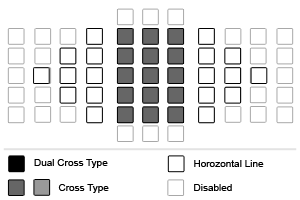
Comments
There are no comments on this article yet. Why don't you start the discussion?